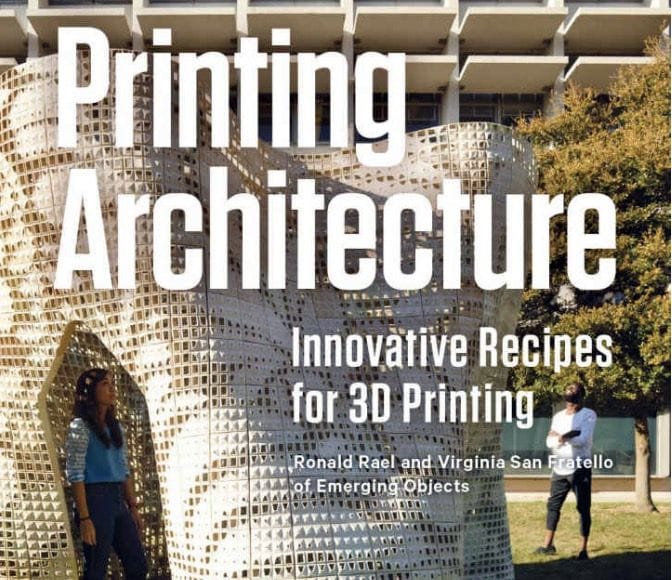![Printing Architecture [Source: Amazon]](https://fabbaloo.com/wp-content/uploads/2020/05/image-asset_img_5eb0a075067c8.jpg)
This week’s selection is “Printing Architecture: Innovative Recipes for 3D Printing” by Ronald Rael and Virginia San Fratello.
When you consider the notion of 3D printed architecture, you immediately begin thinking big: big buildings with huge walls, somehow 3D printed. While that may at some point in the future be a thing, it really isn’t the case quite yet.
But that doesn’t mean there is no role for 3D printing in today’s world of architecture. Architecture is the design of buildings far beyond the walls, but including all elements of the design that lead to a successful functional and aesthetic experience when using a building.
That means there are more things to 3D print than merely the large structural elements. There are in fact many smaller components that contribute greatly to the architectural experience.
And that seems to be the focus for Printing Architecture. Rael is Professor of Architecture at UC Berkeley, and is also co-founder of Rael San Fratello architects, with his partner and co-author of this book, Virginia San Fratello. She is an Associate Professor of Interior Design at San Jose State University.
The two have also partnered on Emerging Objects, a firm that markets Potterware, a tool for designing 3D models specifically for pottery.
In Printing Architecture the authors explore the idea of using what they call “unnatural materials” for producing architectural artifacts.
Some of the unusual materials they discuss include salt, sawdust, coffee, tea, wine waste, rubber, bioplastic, sand, cement and clay.
You might be wondering how one could 3D print such unusual materials. It’s done by using a binder jetting process in which a powder is selectively glued together, layer by layer. This is the same principle used by the old Z Corp machines and persists today in its later incarnations.
The issue is exactly what is the binder and mix of powders to achieve usable structures? This is the key of his book: the recipes used to form successful 3D prints such as these bowls, printed in a mixture of cement, wood and salt:
![3D printed bowls made from cement, wood and salt [Source: Amazon]](https://fabbaloo.com/wp-content/uploads/2020/05/image-asset_img_5eb0a0755e1b9.jpg)
Evidently the authors collaborated with researchers at the University of Washington, who have long been experimenting with the process of 3D printing ceramics, clays and similar materials.
It’s a very different area of 3D printing that many may not be familiar with, and perhaps one that deserves a bit more attention.
My hope is that there will be more choices for 3D printing equipment that can handle this type of 3D print materials in the future.
Via Amazon











This week’s selection is “3D Printing Projects” by Dorling Kindersley, a.k.a. “DK”.